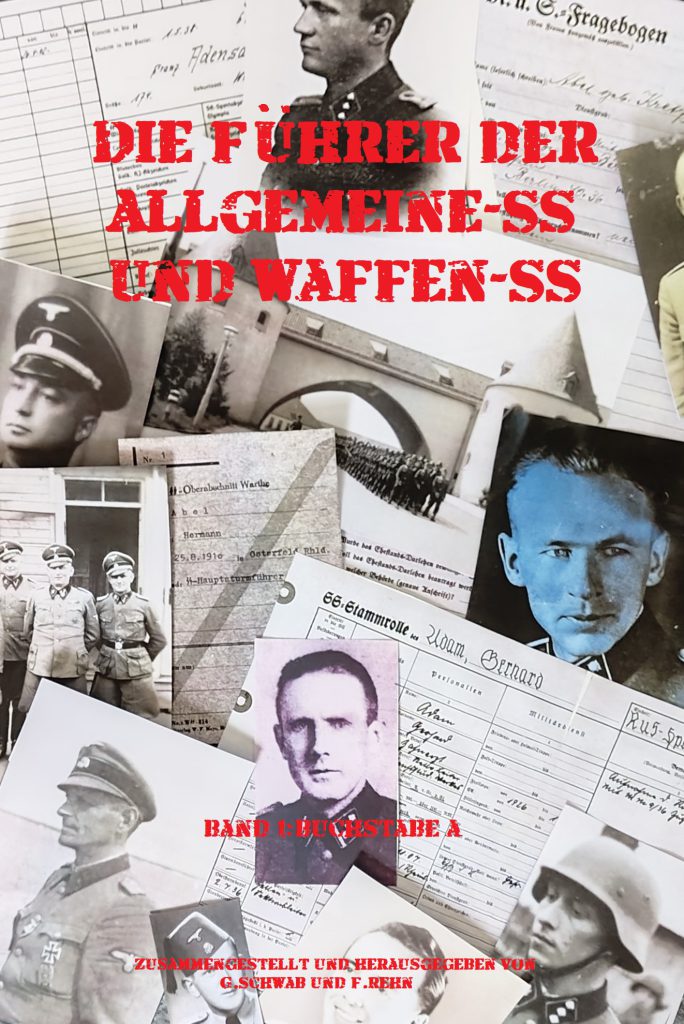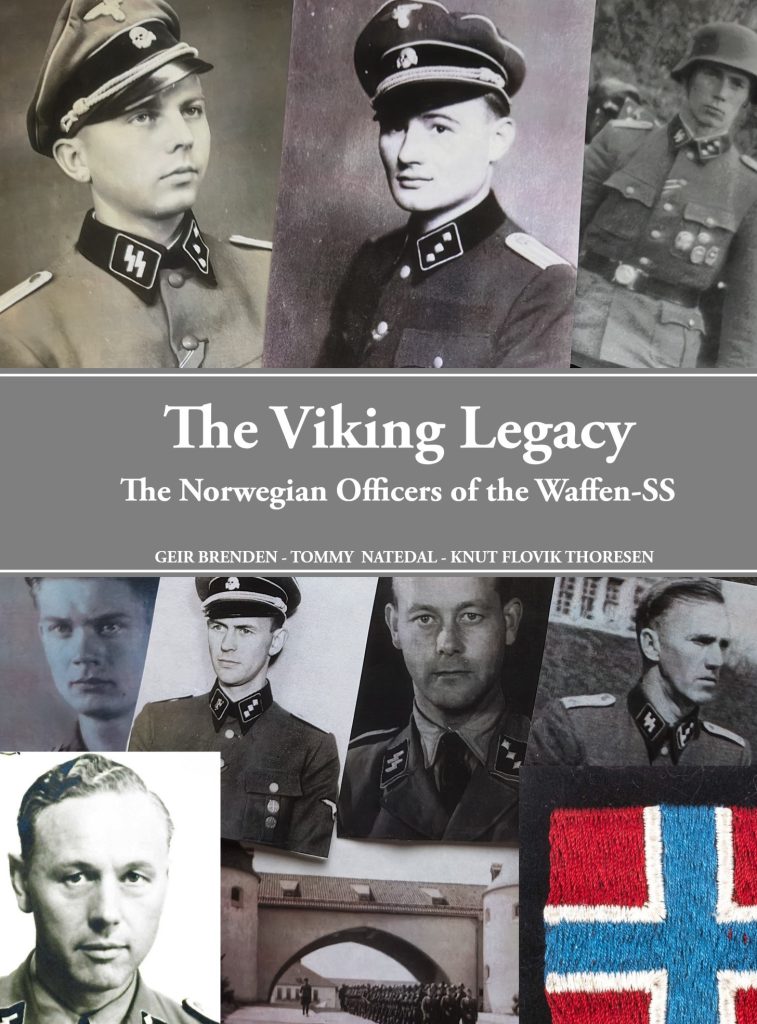The 1. SS-Panzer-Division Leibstandarte SS Adolf Hitler (LSSAH or LAH) was formed 17 March 1933 as SS-Stabswache Berlin by Josef “Sepp” Dietrich, Hitler’s bodyguard, on the order of Adolf Hitler who wanted a full-time armed force that was completly loyal to him.
Dietrich handpicked 120 men (some of whom had served in the Stosstrupp Adolf Hitler that was formed in 1921) who were barracked at the Alexander Barracks in Berlin and later at Berlin-Lichterfelde.
It was soon redesignated SS-Sonderkommando Zossen and a new unit, SS-Sonderkommando Jüterbog, was raised. These units merged September 1933 as was designated SS-Leibstandarte Adolf Hitler (LAH). The members of LAH took an oath of loyalty to Hitler 9 November 1933 (the 10th anniversary of the failed Beer Hall Putsch). It was redesignated Leibstandarte SS Adolf Hitler (LSSAH) in 1934.
It took part in the purge of Ernst Röhm and other enemies of Hitler (mainly leaders of the SA) during the Night of Long Knifes together with Landespolizeigruppe General Göring. It was motorised and expanded October 1934 as a reward for its loyalty and services during the “Röhm-Putsch”.
What my fate is, my men of the Leibstandarte, I do not know. But I know one thing, that you will be in the front line of every action. As long as I have the honor of leading the struggle at the head of the Reich, it is also an honor for you, who bear my name, to be at the forefront of the struggle!
Adolf Hitler in a speech to LSSAH 26 Dec 1940 in Metz (1)
I came to the Leibstandarte SS Adolf Hitler on 1 May 1941. As a Berliner there was never any doubt in my mind that I would volunteer for this unit. I had often seen them on parades in the city, on guard at the Reichs Chancellery and so on. Good uniform, comradeship and above all they were all very tall men, at least 1,82m tall.
SS-Unterscharführer Erwin Bartmann (2)
LSSAH took part in the annexation of Austria as a part of XVI. Armee-Korps under General Heinz Guderian. On 10 March Sepp Dietrich mobilized trucks from the Reichspost (Post service) and busses from the Berliner Verkehrsgesellschaft (Public Transport authority of Berlin) to be able to transfer his troops south to meet up with the 2. Panzer-Division. It later took part in the invasion of Czechoslovakia.
It was attached to Heeresgruppe Süd during the invasion of Poland and saw its first action along the Prosna river.
XIII Armeekorps was critical of the performance of LAH in Poland and in a report following its departure wrote:
The Leibstandarte Adolf Hitler was only partially capable of fulfilling its mission. It did capture the bridge at Gola in a surprise attack, but then fell into an ambush on the main road on the southern edge of Boleslawez. There the unit suffered its first casualties and let itself get embroiled in frontal house-to-house combat with weak enemy forces but to which the Leibstandarte was not equal in regard to infantry combat training.
The bulk of the Leibstandarte was not put into action. The possibility of going around the enemy east of Boleslawez was not exploited; the heavy artillery was used for shelling from house to house, and the unit only moved forward when all life appeared to have been destroyed. In this manner, the battle was only conducted with the frontmost companies; the rest of the Standarte stayed right behind them. Actual leadership of the Standarte did not occur. By evening, the Leibstandarte had not reached Wieruszow, but rather the vicinity of Meleschin. The mission was not accomplished. (4)
It later took part in the invasion of France and the Low Countries were it was mainly held in reserve though it was used against the retreating British troops at Dunkirk. LSSAH was attached to XIV Armeekorps during the second and final phase of the invasion of France.
Following the armistice the LSSAH was to rest and be upgraded to a brigade while training amphibious warfare for the planned invasion of Britain (Unternehmen Seelöwe). This invasion was cancelled and LSSAH was transferred to Romania for the invasion of the Balkans. It fought its way through Yugoslavia and Greeve chasing the Allied troops to Kalamata, from where they were evacuated by sea to Crete.
LSSAH took part in Unternehmen Barbarossa (the invasion of the Soviet Union) attached to Heeresgruppe Süd and saw action at Kiev and Rostov. It was transferred to France for refitting 1942 and was upgraded to a Panzergrenadier-DIvision. It returned to the Eastern front 1943 and fought at Kharkov and Kursk. After the failure at Kursk, LSSAH was sent to Italy on anti-partisan duty but it soon was sent back to the Eastern front this time as a Panzer-Division. LSSAH was one of the divisions encircled near Kamenets-Podolsk and though it was saved by 9. SS-Panzer-Division Hohenstaufen and 10. SS-Panzer-Division Frundsberg it suffered heavy losses and was sent to France for rest and refitting.
It fought in Normandy following the Allied invasion and saw action at Caen, Falaise and Aachen as it was pressed back towards Germany. It took part in the offensive in the Ardennes attached to I SS Panzerkorps. After the failure of that offensive LSSAH was once again sent to the Eastern front to take part in the offensive to break the siege of Budapest (Unternehmen Margarethe). Following that failed offensive it was transferred to Austria where it surrendered to the American troops at the end of the war.
History of 1st SS-Aufklärungs-Abteilung Leibstandarte SS “Adolf Hitler”.
The LAH along the Prosna river – September 1939.
Known war crimes
SS-Obermusikmeister Hermann Müller-John ordered 50 civilians, several of them Jews, shot at Błonie, Poland in September 1939. Generalleutnant Joachim Lemelsen, commander of 29. Infanterie-Division (mot) reports of these murders to his superiors and General Walter von Reichenau, commander of 10. Armee orders the arrest of Müller-John. A few days later Adolf Hitler places the SS troops under seperate SS juristiction at the request of Heinrich Himmler and the investigation into the killings is dropped. (7)
On 1 September 1939 34 civilians were killed in Torzeniec by soldiers from the Pionierzug under command of SS-Obersturmführer Christian Hansen. (10)
Soldiers from LSSAH killed several civilians in Bolesławiec in the early days of the invasion of Poland and numerous such atrocities happened where soldiers from the unit advanced. (11)
On 3-4 September 1939 soldiers from Infanterie-Regiment 95 of the 17. Infanterie-Division and Leibstandarte killed close to 200 civilians in Złoczew, the reason for this massacre is not known. It was investigated post-war by both Poland and West German authorities but no clear motive was found. (12)
Generalmajor Herbert Loch, commander of 17. Infanterie-Division that operated closely with LSSAH during the invasion of Poland complained about the LSSAH and their wild firing and tendency to reflexively set villages alight as they passed through them. (13)
On 28 May 1940 80 British POWs from the 48th Division were killed at Wormhout by soldiers from the 2nd Battalion commanded by SS-Hauptsturmführer Wilhelm Mohnke.
Six soldiers of LSSAH were captured by Soviet troops in Tagarog in October 1941 and then tortured and murdered. After the bodies were located in March 1942 an order was issued that all Soviet soldiers captured during following three days be shot, an estimated 4000 were killed. (3)
Vehicles from LSSAH (most likely from SS-Wach-Bataillon 1) were used in the rounding up of Jewish factory workers in Berlin during November 1942. (6)
During the recapture of Kharkov in March 1943 LSSAH is accused of killing some 700 wounded Soviet soldiers in the 1st Army Marshalling Hospital but it should be noted that it is unclear it this massacre is more than just an allegation.
Soldiers of LSSAH were involved in the killing of 22 Italian Jews in the area of Lago Maggiore in September 1943. Five soldiers were put on trial for these crimes post-war. (9)
On 19 September 1943 the Italian town of Boves was shelled by troops commanded by Joachim Peiper and 34 civilians killed in retaliation for the capture of two Waffen-SS officers. (8)
In Tavaux, France, 30 August 1944 soldiers from I./SS-Pz.Gren.Rgt.25 (of 12. SS-Panzer-Division Hitlerjugend) together with soldiers from LSSAH killed 21 civilians.
A soldier of LAH was sentenced to five years in prison post-war for the shooting of two escaped Soviet POWs near Oberlind, Germany, March 1945.
Several massacres of civilians and captured US troops during the battle of the Bulge including:
On 17 December 1944 soldiers from Kampfgruppe Peiper killed 86 captured US troops at the Baugneuz crossroads, Malmedy.
11 Africa-American soldiers of the 333rd Field Artillery Battalion, an all-black unit of the segregated US Army, was tortured and killed by LSSAH soldiers at Wereth 17 December 1944.
On 19 December 1944 soldiers from Kampfgruppe Knittel commanded by SS-Untersturmführer Heinrich Dröge killed 24 civilians at Parfondruy. A total of at least 130 Belgian civilians were killed in the area of Stavelot, Renardmont & Parfondruy and post-war SS-Obersturmführer Heinz Goltz was sentenced to 15 years in prison for these atrocities.
Lineage
SS-Stabswache Berlin (Mar 1933 – May 1933)
SS-Sonderkommando Zossen (May 1933 – Sep 1933)
Leibstandarte SS Adolf Hitler (Sep 1933 – Dec 1934)
Leibstandarte SS Adolf Hitler (mot) (Dec 1934 – July 1942)
SS-Division (mot) LSSAH (July 1942 – Nov 1942)
SS-Panzergrenadier-Division LSSAH (Nov 1942 – Oct 1943)
1. SS-Panzer-Division LSSAH (Oct 1943 – May 1945)
Commanders
SS-Oberstgruppenführer Joseph Dietrich (1 Sep 1939 – 4 July 1943)
SS-Brigadeführer Theodor Wisch (4 July 1943 – 20 Aug 1944)
SS-Brigadeführer Wilhelm Mohnke (20 Aug 1944 – 6 Feb 1945)
SS-Brigadeführer Otto Kumm (6 Feb 1945 – 8 May 1945)
Chief of Staff
SS-Standartenführer Wilhelm Keilhaus (13 Aug 1940 – 6 Apr 1941)
SS-Hauptsturmführer Rudolf Lehmann (6 Apr 1941 – 15 July 1942)
SS-Standartenführer Wilhelm Keilhaus (15 July 1942 – 17 July 1942)
SS-Hauptsturmführer Rudolf Lehmann (17 July 1942 – ? Apr 1944)
SS-Obersturmbannführer Erich Grensing (? Apr 1944 – 2 Sep 1944)
SS-Obersturmbannführer Dietrich Ziemssen (2 Sep 1944 – ? Dec 1944)
SS-Sturmbannführer Ralf Tiemann (? Dec 1944 – 15 Jan 1945)
SS-Obersturmbannführer Dietrich Ziemssen (? Mar 1945 – ? May 1945)
Area of operations
Poland & Eastern front, southern sector (June 1941 – July 1942)
France (July 1942 – Jan 1943)
Eastern front, southern sector (Jan 1943 – Aug 1943)
Italy (Aug 1943 – Oct 1943)
Eastern front, southern sector (Oct 1943 – Apr 1944)
Belgium, France & Western Germany (Apr 1944 – Dec 1944)
Ardennes (Dec 1944 – Jan 1945)
Western Germany (Jan 1945 – Mar 1945)
Hungary & Austria (Mar 1945 – May 1945)
Manpower strength
Jan 1935 2.531
Jan 1936 2.650
Jan 1937 3.177
Jan 1938 3.607
Dec 1938 3.626
June 1941 10.796
Dec 1942 20.844
Dec 1943 19.867
June 1944 19.691
Dec 1944 22.000 Manpower strength (7 April 1945)
– 57 Officers
– 229 NCO
– 1.296 Soldiers
– 16 Operational tanks
Honor titles
This division evolved from Hitler’s personal bodyguard regiment, which is also quite precisely what the name translates to.
Holders of high awards
Holders of the Close Combat Clasp in Gold (16)
Holders of the Commendation Certificate of the Commander-in-Chief of the Army for Shooting Down Aircraft (1)
– Schömer, [first name not listed], 16.05.1942 (90), SS-Sturmmann, Stabskp./LSSAH
Holders of the German Cross in Gold (101)
Holders of the German Cross in Silver (2)
– Eggers, Wilhelm, 15.01.1944, SS-Obersturmführer Technischer Führer (K) Instandsetzung, SS-Stu.Gesch.Abt. 1 LSSAH
– Stoltz, Georg-Günther, 02.06.1944, SS-Obersturmbannführer, Ib 1. SS-Pz.Div. LSSAH
Holders of the Honor Roll Clasp of the Heer (14)
Holders of the Knight’s Cross (65, including one unofficial/unconfirmed)
Unit-Level Commendation Certificate of the Commander-in-Chief of the Army for Shooting Down Aircraft (2)
– 11./Leibstandarte SS Adolf Hitler
— Date/Place of Downing: 13.10.1941 bei Troizkoje
— Award Date: 16.05.1942 (91)
– 12./Leibstandarte SS Adolf Hitler
— Date/Place of Downing: 14.10.1941 bei Troizkoje
— Award Date: 16.05.1942 (92)
Order of battle – Leibstandarte SS Adolf Hitler (Oct 1934)
Stab SS-Standarte (mot)
Stäbe SS-Sturmbann (mot) x 3
SS-Kradschützen-Sturm
SS-Schützen-Stürme (mot) x 9
SS-Maschinengewehr-Stürme (mot) x 3
SS-Minenwerfer-Sturm (mot)
SS-Nachrichten-Züge (mot) Stab SS-Standarte x 3
SS-Nachrichten-Züge (mot) Stab SS-Sturmbann (mot) x 3
SS-Panzerspäh-Zug
SS-Musikzug SS-Standarte
Order of battle – Leibstandarte SS Adolf Hitler (1 Sep 1939 – 13 Aug 1940)
I. Sturmbann “LSSAH”
– 1. Sturm
– 2. Sturm
– 3. Sturm
– 4. Sturm (MG-Sturm)
II. Sturmbann
– 5. Sturm
– 6. Sturm
– 7. Sturm
– 8. Sturm (MG-Sturm)
III. Sturmbann
– 9. Sturm
– 10. Sturm
– 11. Sturm
– 12. Sturm (MG-Sturm)
– 13. Sturm (Le.IG-Sturm)
– 14. Pz.Jäg.Sturm
– 15. Kradschützesturm
– 16. sIG-Sturm
IV. Wachtbatallion (later Wachtruppe Berlin), also known as V. Sturmbann IV.
Artillerie-Regiment
– 10. Bttr. IV Art.Rgt.
– 11. Bttr. IV Art.Rgt.
– 12. Bttr. IV Art.Rgt.
Pz.Späh.Zug “LSSAH”
Nachrichtenzug Nachrichtensturmbann “LSSAH”
Kradmeldezug “LSSAH”
Kraderkundungszug “LSSAH”
Pionierzug Pioniersturm “LSSAH”
Pz.Sturm Batterie
Musik-Zug “LSSAH”
Le.Inf. Kolonne “LSSAH”
Order of battle – Leibstandarte SS Adolf Hitler (13 Aug 1940 – 15 July 1942)
I. Batallion “LSSAH”
– 1. I. Batallion “LSSAH”
– 2. I. Batallion “LSSAH”
– 3. I. Batallion “LSSAH”
– 4.(MG) I. Batallion “LSSAH”
– 5.(s) I. Batallion “LSSAH”
II. Batallion “LSSAH”
– 6. II. Batallion “LSSAH”
– 7. II. Batallion “LSSAH”
– 8. II. Batallion “LSSAH”
– 9.(MG) II. Batallion “LSSAH”
– 10.(s) II. Batallion “LSSAH”
III. Batallion
– 11. III Batallion “LSSAH”
– 12.(MG) III. Batallion “LSSAH”
– 13. “LSSAH”
– 14.(MG) “LSSAH”
– 15.(s) “LSSAH”
IV. Batallion (from 10 June 1941)
– 16. “LSSAH”
– 17. “LSSAH”
– 18. “LSSAH”
– 19. “LSSAH”
– 20. “LSSAH”
V. Wach-Batallion
Schweres Batallion “LSSAH”
– 1. Le.IG “LSSAH”
– 2. s.IG “LSSAH”
– 3. 5 cm Pz.Jäg.”LSSAH”
VI. Batallion (from Ersatz-Abteilung “LSSAH” 16 Mar 1942)
VII. Batallion (15 Jan 1941)
Abteilung Schönberger
– 1. Sturmgeschütz-Batterie
– 2. Panzer-Jäger (4.7 cm) Kompanie
Panzer-Abteilung “LSSAH” (from Feb 1942)
Artillerie-Regiment “LSSAH”
– I. Art.Rgt.1 “LSSAH”
— 1. Batterie
— 2. Batterie
— 3. Batterie
– II. (s)Art.Rgt.”LSSAH”
— 4. (s) Batterie
— 5. (s) Batterie
— 6. (8,8 cm) Batterie
— 7. (8,8 cm) Batterie
— 8. (10 cm) Batterie Kanonen-Batterie “LSSAH”
Aufklärungs-Abteilung “LSSAH”
– 1. Krad. Kompanie
– 2. Krad. Kompanie
– 3. Pz.Späh. Kompanie
– 4. (s). Kompanie Nachrichtenzug
Flakzug (2 cm)
– 1. (3.7 cm) Batterie
– 2. (3.7 cm) Batterie
– 3. (2 cm) Batterie
Le. Flak-Kolonne (40 T, Mot)
Pionier-Batallion “LSSAH”
Pi.Kolonne
Brückenkolonne
– 1. Pi.Kompanie
– 2. Pi.Kompanie
– 3. Pi.Kompanie
Nachrichten-Abteilung “LSSAH”
– 1. (Fe) Kompanie
– 2. (Fu) Kompanie
Le.Nachrichten-Kolonne
Nachschubtruppen “LSSAH”
– 1. Kraftwagen-Kolonne
– 2. Kraftwagen-Kolonne
– 3. Kraftwagen-Kolonne
– 4. Kraftwagen-Kolonne
– 5. Kraftwagen-Kolonne
– 6. Kraftwagen-Kolonne
– 7. Betriebsstoff-Kolonne
– 8. Betriebsstoff-Kolonne
Werkstatt-Kompanie
Waffen-Werkstatt-Zug
Bäckerie-Kompanie
Schlächterie-Kompanie
Verpflegungsamt
Feldpostamt
Sanitätsdienste
– 1. Sanitäts-Kompanie
– 2. Sanitäts-Kompanie
– Feldlazarett
– Internist
– Chirurg
– Kranken-Kraftwagen-Zug
Order of battle – SS-Division (mot.) Leibstandarte SS Adolf Hitler (15 July 1942 – 22 Oct 1942)
Infanterie-Regiment (mot) 1 “LSSAH”
– I. Inf.Rgt. 1 “LSSAH”
— 1. Inf.Rgt.1 “LSSAH”
— 2. Inf.Rgt.1 “LSSAH”
— 3. Inf.Rgt.1 “LSSAH”
— 4.(MG) Inf.Rgt.1 “LSSAH”
— 5.(s) Inf.Rgt.1 “LSSAH”
– II. Inf.Rgt.1 “LSSAH”
— 6. Inf.Rgt.1 “LSSAH”
— 7. Inf.Rgt.1 “LSSAH”
— 8. Inf.Rgt.1 “LSSAH”
— 9.(MG) Inf.Rgt.1 “LSSAH”
— 10.(s) Inf.Rgt.1 “LSSAH”
– III. Inf.Rgt.1 “LSSAH”
— 11. Inf.Rgt.1 “LSSAH”
— 12. Inf.Rgt.1 “LSSAH”
— 13. Inf.Rgt.1 “LSSAH”
— 14.(MG) Inf.Rgt.1 “LSSAH”
— 15(s) Inf.Rgt.1 “LSSAH”
— 16.(Flak) Inf.Rgt.1 “LSSAH”
— 17.(IG) Inf.Rgt.1 “LSSAH”
— 18.(Pz.Jäg.) Inf.Rgt.1 “LSSAH”
Infanterie-Regiment (mot) 2 “LSSAH”
– I. Inf.Rgt.2 “LSSAH”
— 1. Inf.Rgt.2 “LSSAH”
— 2. Inf.Rgt.2 “LSSAH”
— 3. Inf.Rgt.2 “LSSAH”
— 4.(MG) Inf.Rgt.2 “LSSAH”
— 5.(s) Inf.Rgt.2 “LSSAH” II. Inf.Rgt.2 “LSSAH”
— 6. Inf.Rgt.2 “LSSAH”
— 7. Inf.Rgt.2 “LSSAH”
— 8. Inf.Rgt.2 “LSSAH”
— 9. Inf.Rgt.2 “LSSAH”
— 10. Inf.Rgt.2 “LSSAH”
III.(Gep). Inf.Rgt.2 “LSSAH”
– 11.(Gep) Inf.Rgt.2 “LSSAH”
– 12.(Gep) Inf.Rgt.2 “LSSAH”
– 13.(Gep) Inf.Rgt.2 “LSSAH”
– 14.(Gep) (s) Inf.Rgt.2 “LSSAH”
– 15.(Flak) Inf.Rgt.2 “LSSAH”
– 16.(IG) Inf.Rgt.2 “LSSAH”
– 17.(Pz.Jäg.) Inf.Rgt.2 “LSSAH”
– 18.(Aufkl.) Inf.Rgt.2 “LSSAH”
SS-Panzer-Regiment 1 “LSSAH”
– I. Pz.Rgt.1 “LSSAH”
— 1. Kompanie
— 2. Kompanie
— 3. Kompanie
— 4. Kompanie
— le.Kolonne “I. Pz.Abt.1 “LSSAH”
– II. Pz.Rgt.1 “LSSAH”
— 5. Kompanie
— 6. Kompanie
— 7.Kompanie
— le-Kolonne “II. Pz.Abt.1 “LSSAH”
Panzer-Werstatt-Kompanie
Panzer-Pionier-Kompanie
Artillerie-Regiment 1 “LSSAH”
– I.(Le) Art.Rgt.1 “LSSAH”
– II. Art.Rgt.1 “LSSAH”
– III. Art.Rgt.1 “LSSAH”
Aufklärungs-Abteilung 1 “LSSAH”
– 1. Krad-Kompanie (VW)
– 2. Krad-Kompanie (VW)
– 3. le. SPW-Kompanie
– 4. Pz.Späh-Kompanie
– 5. (s) Kompanie
Nachrichtenzug
Flakzug
Panzer-Jäger-Abteilung 1 “LSSAH”
Flak-Abteilung 1 “LSSAH”
Pionier-Batallion 1 “LSSAH”
Nachrichten-Abteilung 1 “LSSAH”
Nachschubtruppen 1 “LSSAH”
Instandsetzungs-Abteilung 1 “LSSAH”
Verwaltungsdienste Wirtschafts-Batallion “LSSAH”
Sanitäts-Abteilung 1 “LSSAH”
Order of battle – SS-Panzergrenadier-Division Leibstandarte SS Adolf Hitler (22 Oct 1942 – 22 Oct 1943)
As SS-Division (mot.) Leibstandarte SS Adolf Hitler with the following exeptions:
Beobachtungs-Batterie
Sturmgeschütz-Abteilung
Div.Sicherungs-Kompanie
Feldgendarmerie-Kompanie
Inf.Rgt. reformed as Pz.Gren.Rgt. 1 resp. 2
Order of battle – 1. SS-Panzer-Division Leibstandarte SS Adolf Hitler (22 Oct 1943 – 8 May 1945)
As SS-Panzergrenadier-Division Leibstandarte SS Adolf Hitler with the following exeptions:
SS-Werfer-Abteilung (5)
Notable members
Otto Beisheim (Industrialist and founder of the Metro Group)
Wolf Berger (Son of SS-Obergruppenführer Gottlob Berger, KIA with LSSAH on 11 February 1943)
Josef Bürckel (Son of SS-Obergruppenführer & Gauleiter Josef Bürckel, KIA with LSSAH on 1 August 1944)
Josef “Sepp” Dietrich (Member of the Reichstag, Holder of the Knight’s Cross with Oak Leaves, Swords and Diamonds)
Johannes Hendrik “Henk” Feldmeijer (Voorman, leader, of the Germaansche-SS in Nederland, the Dutch SS)
Otto Günsche (Personal adjutant to Adolf Hitler, took part in the burning of Hitlers body following his suicide)
Klaus Havenstein (post-war a well-known actor)
Thorulf Hillblad (Active in the German radio-propaganda aimed at Sweden, the Köningsbergsradion, 1939-1941)
Hans Hermann Junge (Valet to Adolf Hitler 1940-1943, husband of Traudl Junge, Adolf Hitler’s private secretary)
Ernst-Günther Krätschmer (Author of the classic reference book “Ritterkreuzträger der Waffen-SS”)
Ernst Krause (painter, his most famous work being “Ritterkreuzträger der LSSAH” that was given to Hitler as a gift by LSSAH and was later in the Great German Exhibition in Munich, 1942, and designer of the Medal for the Winter Campaign in Russia 1941-42 served in LSSAH as war correspondent)
Karl Krause (Valet to Adolf Hitler 1934-1939)
Eberhard von Künsberg (Commander of the infamous Sonderkommando Ribbentrop)
Jonas Lie (Minister of the Norwegian Police and commander of Norges SS, served as war correspondent with LAH in the Balkans, wrote “Over Balkans syv blåner” about this time)
Heinz Linge (Chief valet to Adolf Hitler, took part in the burning of Hitlers body following his suicide)
Hans Malkomes (Usually credited with 24 destroyed tanks but the exact number is unknown)
Werner Naumann (State Secretary in Joseph Goebbels’ Propagandaministerium and appointed head of the Propaganda Ministry in Hitler’s will)
Joachim “Jochen” Peiper (Youngest regimental commander in the Waffen-SS, adjutant to Heinrich Himmler 1938-1941, involved in several war crimes)
Hans Friedrich Georg Pfeiffer (Adjutant to Adolf Hitler)
Rudolf von Ribbentrop (Son of the Foreign Minister Joachim Von Ribbentrop)
Hans-Georg Schulze (Adjutant to Adolf Hitler)
Richard Schulze (Adjutant to Adolf Hitler and to Joachim von Ribbentrop, name changed to Schulze-Kossens post-war)
Wolfgang Venohr (Author and journalist, published several books on the resistance to Hitler and Prussian history)
Herbert Walther (Author of several books on the Waffen-SS)
Paul Wegener (SS-Obergruppenführer, Gauleiter of Weser-Ems, Reichstag deputy, served briefly in LAH during the campaign in Greece)
Balthasar “Boddy” Woll (The only tank gunner to receive the Knight’s Cross)
Max Wünsche (Adjutant to Adolf Hitler 1938-1940)
Officers serving in the Einsatzgruppen and Concentration Camps
Concentration Camps 16
Einsatzgruppen 4
(includes officers serving in the Einsatzgruppen or Concentration Camps either prior to or after service in this unit)
Insignia
The vehicle insignia was a skeleton-key (“dietrich” in German) in a shield chosen after the commander Joseph “Sepp” Dietrich. When he was awarded oak leaves to his Knight’s Cross oak leaves were painted below the insignia.
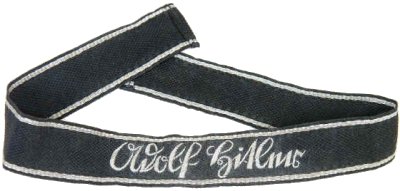
The “Adolf Hitler” cuff title was authorized for this unit May 1934.
(Courtesy of N & T Global Trading)
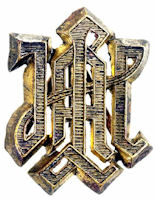
On the shoulder boards a LAH cypher was worn, embroidered for enlisted men, white metal for NCOs and bronzed or gilted metal of officers.
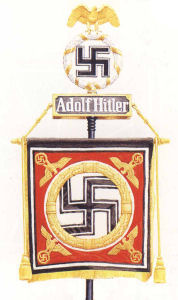
LAH standard, second type
The second type standard was designed by Professor Carl Diebitsch and was presented to the LSSAH in Metz 9 September 1940 by RFSS Heinrich Himmler, the original Deutschland Erwache standard was placed in the Berlin-Lichterfelde barracks.
The standard was captured by the Red Army at the end of the war, during the victory parade in Moscow the standard staff was displayed but not the standard itself and it was believed to have been lost. It was however located in the Central Armed Forces Museum in Moscow in 1990 by George A. Petersen.
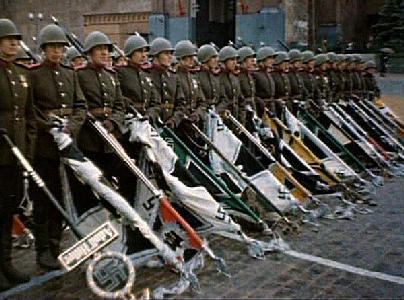
Propaganda
Two examples of the propaganda produced about the division: “Drei von der Leibstandarte: Erlebnisse im Polenfeldzug” (1941) and “Soldaten der Leibstandarte SS Adolf Hitler im Kampf” (1943).
In fiction
The three Tiger I tanks in the 1970 movie “Kelly’s Heroes” directed by Brian G. Hutton are from the LSSAH as seen by the skeleton key markings.
The 1989 movie “Indiana Jones and the Last Crusade” directed by Steven Spielberg feature several LSSAH members among the villains, including SS-Standartenführer Ernst Vogel, as shown by the cuff titles.
The 2004 movie “Saints and Soldiers” directed by Ryan Little about a group of US soldiers trapped behind enemy lines after escaping the Malmedy massacre features soldiers from Kampfgruppe Peiper.
The alternate history novel “Marching Through Georgia” (first in “The Domination” trilogy) by S. M. Stirling, depicts the LSSAH fighting a Draka airborne landing in German occupied Soviet Georgia.
In the 2008 alternate history novel “The Man With the Iron Heart” by Harry Turtledove, Joachim Peiper becomes the leader of the post-war resistance movement Werewolves (or German Freedom Front) following the killing of the previous leader Reinhard Heydrich in 1947.
Adolf Hitler visiting LAH
(Courtesy of Bob P.)
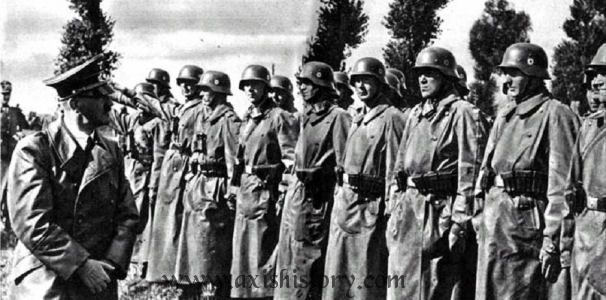
LSSAH on parade in Berlin-Lichterfelde 23 May 1935 with Sepp Dietrich on the stand
(Courtesy of Bundesarchiv/Wikimedia, licensed under Creative Commons Attribution ShareAlike 3.0 Germany)
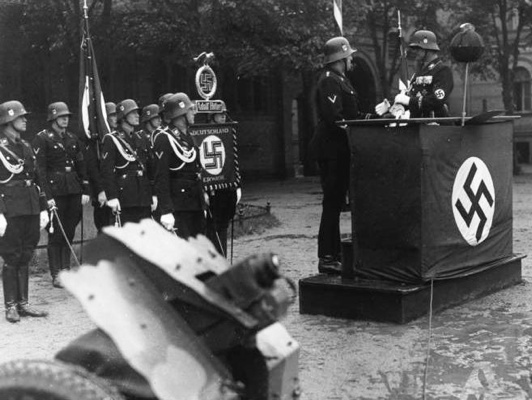
LSSAH men taking part in a SS-raid against a Jewish community in Vienna in March 1938
(Courtesy of Bundesarchiv/Wikimedia, licensed under Creative Commons Attribution ShareAlike 3.0 Germany)
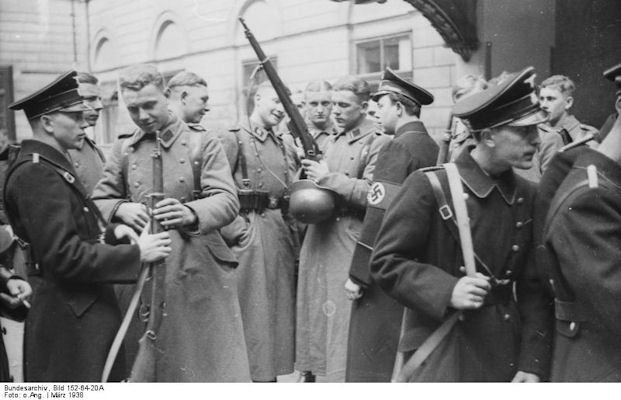
LSSAH at their barracks at Berlin-Lichterfelde 1938
(Courtesy of Bundesarchiv/Wikimedia, licensed under Creative Commons Attribution ShareAlike 3.0 Germany)
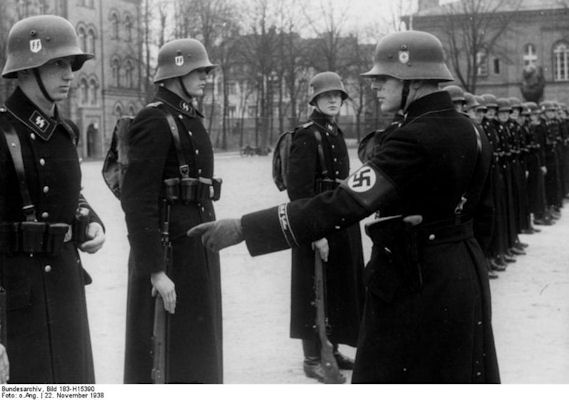
LSSAH soldiers in Charkow
(Courtesy of Bundesarchiv/Wikimedia, licensed under Creative Commons Attribution ShareAlike 3.0 Germany)
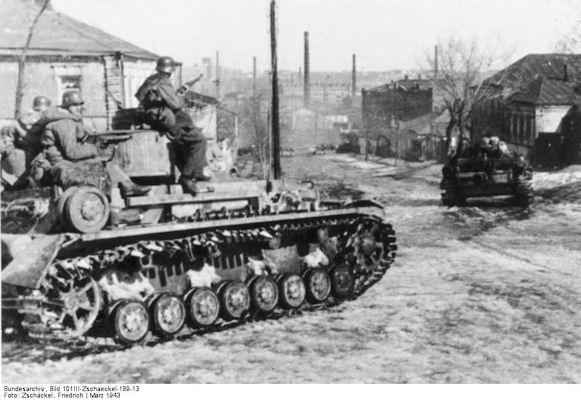
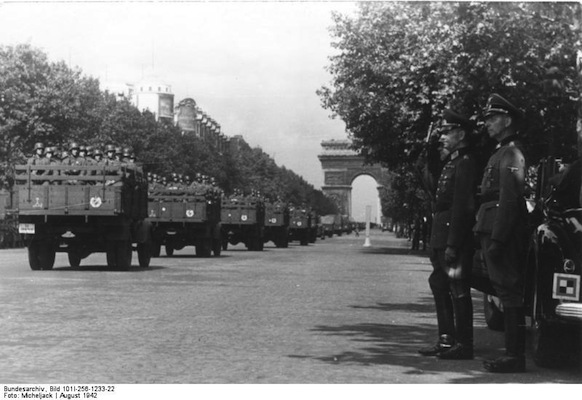
LAH on parade in Paris in August 1942 with the Arc de Triomphe in the background
(Courtesy of Bundesarchiv/Wikimedia, licensed under Creative Commons Attribution ShareAlike 3 0 Germany)
A memorial to the victims of the Malmedy massacre
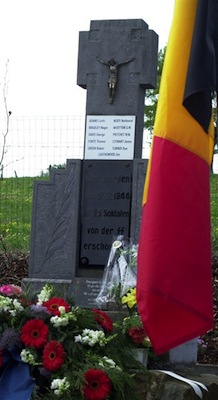
A memorial to the victims of the Wereth massacre
(Courtesy of Department of Defense / Wikimedia)
Footnotes
1. “Twelve Years With Hitler: A History of 1. Kompanie Leibstandarte SS Adolf Hitler 1933-1945” by Hans Quassowski, page 121.
2. “Loyalty is my honour: Personal accounts from the Waffen-SS” by Gordon Williamson, Page 17.
3. It should be noted that doubts has been raised about this atrocity and the number of victims.
4. NARA microfilm series T314, roll number 509, frame numbers 7-10.
5. SS-Werfer-Abteilung 1 was formed in spring 1944 from 10./SS-Artillerie-Regiment 1 and 11./SS-Artillerie-Regiment 1, it was renamed SS-Werfer-Abteilung 501 in October.
6. “The Destruction of The European Jews” Raul Hilberg, page 463-64, “Murderous Elite: The Waffen-SS and its complete record of war crimes” by James Pontolillo, page 34, and “Joseph Goebbels: En biografi” by Lars Ericson Wolke
7. “Murderous Elite: The Waffen-SS and its complete record of war crimes” by James Pontolillo, page 35, “Hitler strikes Poland: Blitzkrieg, Ideology and atrocity” by Alexander B. Rossino, page 109-110.
8. “Murderous Elite: The Waffen-SS and its complete record of war crimes” by James Pontolillo, page 36-38.
9. “Murderous Elite: The Waffen-SS and its complete record of war crimes” by James Pontolillo, page 71-73.
10. “Murderous Elite: The Waffen-SS and its complete record of war crimes” by James Pontolillo, page 140.
11. “Hitler strikes Poland: Blitzkrieg, Ideology and atrocity” by Alexander B. Rossino, page 157-159.
12. “Hitler strikes Poland: Blitzkrieg, Ideology and atrocity” by Alexander B. Rossino, page 159-161.
13. “Hitler strikes Poland: Blitzkrieg, Ideology and atrocity” by Alexander B. Rossino, page 164.
Sources used
National Archives and Records Administration (NARA), microfilm series T314, roll number 509, frame numbers 7-10
John R. Angolia – Cloth insignia of the SS
Roger James Bender & Hugh Page Taylor – Uniforms, Organization and History of the Waffen-SS, vol 2
Christopher R. Browning – The Origins of the Final Solution
Philip H Buss – Divisional signs of the Waffen-SS (Military Advisor, vol 19, number 4)
Stan Cook & Roger James Bender – Leibstandarte SS Adolf Hitler: Uniforms, Organization & History
Georges M. Croisier – Waffen-SS (PDF)
Lars Ericson Wolke – Joseph Goebbels: En biografi
Terry Goldsworthy – Valhalla’s Warriors: A history of the Waffen-SS on the Eastern Front 1941-1945
Colin Heaton – German Anti-Partisan Warfare in Europe 1939-1945
Raul Hilberg – The Destruction of The European Jews
Peter Hoffmann – Hitler’s Personal Security: Protecting the Führer 1921-1945
Traudl Junge – Until the Final Hour: Hitler’s Last Secretary
Steve Kane – Waffen-SS Forces in the Balkans: A checklist (in World War II Journal, Vol 7)
Dr. K-G Klietmann – Die Waffen-SS: eine Dokumentation
Rudolf Lehmann – The Leibstandarte, Vol 1
Peter Lieb – Konventioneller Krieg oder NS-Weltanschauungskrieg?: Kriegführung und Partisanenbekämpfung in Frankreich 1943/44
Clarence Lusane – Hitler’s Black Victims: The Historical Experience of Afro-Germans, European Blacks, Africans and African Americans in the Nazi Era
Kurt Mehner – Die Waffen-SS und Polizei 1939-1945
Andrew Mollo – Uniforms of the SS: Collected Edition
James Pontolillo – Murderous Elite: The Waffen-SS and its complete record of war crimes
Hans Quassowski – Twelve Years With Hitler: A History of 1. Kompanie Leibstandarte SS Adolf Hitler 1933-1945
Marc J. Rikmenspoel – Waffen-SS Encyclopedia
Tim Ripley – The Waffen-SS at War: Hitler’s Praetorians 1925-1945
Alexander B. Rossino – Hitler Strikes Poland: Blitzkreig, Ideology & Atrocity
Peter Schrijvers – The Unknown Dead: Civilians in the Battle of the Bulge
Niclas Sennerteg – Tyskland talar: Hitlers svenska radiostation
Jacek Solarz – SS Verfügungstruppen 1939
James C. Steuard – Tactical Markings of the Waffen-SS, Part 1 (in AFV-G2 Vol 4 No 3)
George H. Stein – The Waffen-SS: Hitler’s Elite Guard at War 1939-1945
Jonathan Sutherland – African Americans at War: An Encyclopedia
Blaine Taylor – The Führer’s Standarte and the Leibstandarte SS Adolf Hitler Standard (in The Military Advisor, Vol 20, No 3)
Frank Thayer – Shoulder strap cyphers of the SS (in The Military Advisor, Vol 9 No 1)
Charles Trang – Leibstandarte 1939-1942
Ulrich of England & Otto Spronk – Deutschland Erwache: History & Development of the Nazi Party and the “Germany Awake” Standards
Gordon Williamson & Thomas McGuirl – German military cuffbands 1784-present
Gordon Williamson – Loyalty is my honour: Personal accounts from the Waffen-SS
Gordon Williamson – The Waffen-SS: 1. to 5. Divisions
Mark C. Yerger – Waffen-SS Commanders: The Army, corps and divisional leaders of a legend (2 vol)
Reference material on this unit
Patrick Agte – Jochen Peiper Commander of Panzer-Regiment “Leibstandarte”
Patrick Agte – Michael Wittmann and the Tiger Commanders of the Leibstandarte (2 vol)
Willi Baldig,Gerhard Kiebuth,Reinhold Sellner,Karl Wortmann – Gefahrten Unser Jugend: Die Flak Abteilung Der Leibstandarte
Erwin Bartmann – Für Volk and Führer: The Memoir of a Veteran of the 1st SS Panzer Division Leibstandarte SS Adolf Hitler
Han Bouwmeester – Beginning of the end: the leadership of SS Obersturmbannführer Jochen Peiper (Command and General Staff College MMAS thesis)
Rupert Butler – SS-Leibstandarte Adolf Hitler: The History of the First SS Division 1934-1945
Stan Cook & Roger James Bender – Leibstandarte SS Adolf Hitler: Uniforms, Organization & History
David Cooke & Wayne Evans – Kampfgruppe Peiper: The Race for the Meuse
Gerd Cuppens – Massacre in Malmédy: Kampfgruppe Peiper in the Ardennes
Timm Haasler, Roddy MacDougall, Stefan De Meyer, Simon Vosters & Hans Weber – Duel in the Mist: The Leibstandarte During the Ardennes Offensive: Kampfgruppe Peiper, Stoumont, December 19th, 1944
Timm Haasler, Roddy MacDougall, Simon Vosters & Hans Weber – Duel in the Mist 2: The Leibstandarte During the Ardennes Offensive
Jack A. English – Surrender Invites Death: Fighting the Waffen Ss in Normandy
Thomas Fischer – Soldiers of the Leibstandarte
Thomas Fischer – The SS-Panzer-Artillery Regiment 1: Leibstandarte Adolf Hitler (LAH), 1940-1945
Thomas Fischer – Von Berlin bis Caen: Entwicklung und Einsätze der Divisions- und Korps-Artillerie der LAH 1939-1945
Steve Kane – The 1st SS Panzer Division in the Battle of the Bulge
Erich Kern – Dance of death
Werner Kindler – Obedient Unto Death: A Panzer-Grenadier of the Leibstandarte-SS Adolf Hitler reports
Johann Kreye – Trotz Verwundung einsatzfähig: Als Soldat der Flak-Abteilung der LSSAH
Rudolf Lehmann – The Leibstandarte (5 Vol)
Rudolf Lehmann – Die Leibstandarte im Bild
Jonas Lie – Over Balkans syv blåner (1942)
Mathieu Longue – Kampfgruppe Knittel: L’odyssee de la SS-Aufklarungs-Abteilung 1
Herbert Maeger – Verlorene Ehre, Verratene Treue: Zeitzeugenbericht eines Soldaten
Kurt Meyer – Grenadiere
Peter Mooney – Dietrich’s Warriors: The History of the 3. Kompanie 1st Panzergrenadier Regiment 1st SS Panzer Division Leibstandarte Adolf Hitler
Hermann Niederleig – Mit der Leibstandarte am Feind: Meine Fronteinsätze bei der Leibstandarte SS Adolf Hitler und der 25. Waffen-Grenadier-Division der SS Hunyadi
George Nipe & Remy Spezzano – Platz der Leibstandarte: The SS-Panzer-Grenadier-Division “LSSAH” and the Battle of Kharkov January – March 1943
Jean-Paul Pallud – Ardennes 1944: Peiper and Skorzeny
Danny S. Parker – Fatal Crossroads: The Untold Story of the Malmedy Massacre at the Battle of the Bulge
Hans Quassowski – Twelve years with Hitler: A History of 1. Kompanie Leibstandarte SS Adolf Hitler 1933-45
Branislav Radovic & Martin Stiles – The Leibstandarte in Greece: The 1st Battalion LSSAH During Operation Marita, 1941
J. Lee Ready – Dietrich’s Boys: The Leibstandarte
Michael Reynolds – The Devil’s Adjutant: Jochen Peiper, Panzer Leader
Walter Schüle & Martin Månsson – Pansarslaget vid Prochorovka
Michael Sharpe & Brian L. Davis – Leibstandarte: Hitler’s Elite Bodyguard
Blaine Taylor – Guarding the Fuhrer
Ralf Tiemann – Chronicle of the 7. Panzer Kompanie
Charles Trang – Leibstandarte (2 vol)
Charles Trang – Leibstandarte Archives
Truppenkameradschaft – 7./8. Kompanie der Leibstandarte SS Adolf Hitler
Hugo Ullerich – Gefährten unserer Jugend: Die Flak-Abteilung der Leibstandarte
Herbert Walther – 1st SS Panzer Division
James J. Weingartner – Hitler’s Guard: The Story of the Leibstandarte SS Adolf Hitler 1933-1945

